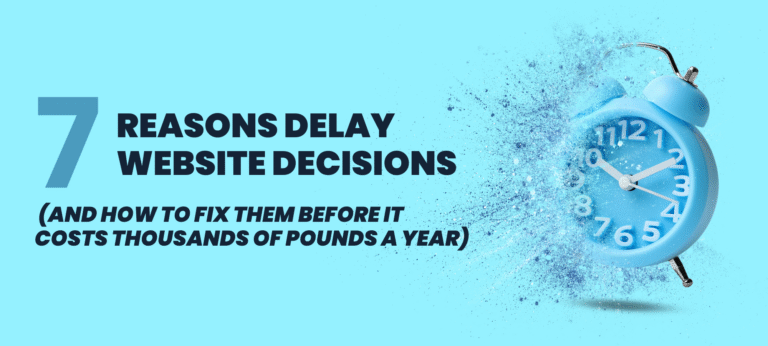Most law firms don’t lose business because their website is bad — they lose it because they wait too long to fix it.
A proposal sits in the inbox. Partners want “one more meeting.” Another quarter passes.
Meanwhile, competitors move up the search results, and new enquiries stay inconsistent.
Research indicates that a large majority of legal clients begin their search online, meaning an under-performing website has a direct impact on enquiries, reputation and trust.
Here are seven common reasons firms delay their website decisions — and how to fix them before it costs thousands of pounds a year in missed opportunities.
1. “We Just Need to Think About It Longer”
This is the most common reason — and often the most expensive.
Delays feel cautious, but time rarely brings new insight. It simply gives competitors more room to grow visibility, gather reviews, and win clients who might have chosen you.
Fix:
Set a firm decision deadline and weigh the cost of inaction.
Ask: “If nothing changes in three months, what does that cost us in lost cases or enquiries?”
2. “It Feels Expensive Right Now”
The question isn’t “Can we afford it?” — it’s “Can we afford not to?”
A modern law firm website typically ranges from £3,000–£5,000, depending on complexity. But the real measure is ROI: a single retained client could pay for the entire investment.
Fix:
Compare expected results, not just prices. Evaluate proposals based on ROI, long-term performance, and conversion strategy rather than headline costs.
3. “We’ve Been Burned by Agencies Before”
Many firms have had disappointing experiences with agencies that overpromise and underdeliver. It’s understandable to hesitate, but doing nothing is still a decision.
Fix:
Prioritise transparency and accountability when choosing a new partner. Ask for easy-to-understand reporting, ownership of all digital assets, and case studies that show measurable outcomes, not just visual design.
4. “We’ll Wait Until Things Pick Up”
Waiting for busy months to fund marketing is a trap. Consistent enquiry flow only happens when investment comes before the next wave of demand.
Fix:
Start small, but start now. Even modest website and visibility improvements can compound quickly. Firms that act early build predictable lead pipelines and smoother cash flow across the year.
5. “I’ll Just Get One More Quote”
Comparing agencies is wise — but comparing on price alone is risky.
Many proposals focus on visuals rather than performance. A cheaper redesign that lacks SEO, content strategy, or clear conversion tracking isn’t cheaper — it’s incomplete.
Fix:
Ask every provider the same key question:
“How will this website generate measurable enquiries or cases?”
The answers will quickly reveal who builds for aesthetics and who builds for results.
6. “We’re Not Ready for a Big Change”
Change can feel overwhelming, especially when internal processes or approvals are involved. But the right partner should make it simple — managing copy, design, and structure while keeping communication clear.
Fix:
Choose an agency that offers a guided process. Look for transparency, staged milestones, and flexibility — so the upgrade happens without disrupting day-to-day operations.
7. “I Need Approval From the Partners First”
Partnership decisions are rarely quick, but the market won’t wait. For every month of indecision, competitors gain online authority that’s harder to catch up to later.
Fix:
Lead with data, not opinions.
Show what inaction costs — for example, missing just one client per week worth £1,000 in fees adds up to over £50,000 per year in unrealised revenue.
Final Thoughts
Hesitation is natural — but delay is costly. A well-performing website is no longer optional for professional credibility or predictable enquiry flow.
Whether you choose to work with an agency, an in-house specialist, or handle it internally, the key is to act decisively and measure success against clear metrics: visibility, enquiries, and return on investment.
When your firm views its website as an asset — not an expense, every digital decision becomes easier to make and easier to justify.





